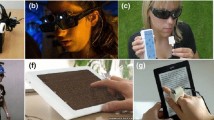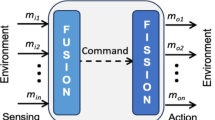Abstract
Blind and visually-impaired people face many problems in interacting with information retrieval systems. State-of-the-art spoken language technology offers potential to overcome many of them. In the mid-nineties our research group decided to develop an information retrieval system suitable for Slovene-speaking blind and visually-impaired people. A voice-driven text-to-speech dialogue system was developed for reading Slovenian texts obtained from the Electronic Information System of the Association of Slovenian Blind and Visually Impaired Persons Societies. The evolution of the system is presented. The early version of the system was designed to deal explicitly with the Electronic Information System where the available text corpora are stored in a plain text file format without any, or with just some, basic non-standard tagging. Further improvements to the system became possible with the decision to transfer the available corpora to the new web portal, exclusively dedicated to blind and visually-impaired users. The text files were reformatted into common HTML/XML pages, which comply with the basic recommendations set by the Web Access Initiative. In the latest version of the system all the modules of the early version are being integrated into the user interface, which has some basic web-browsing functionalities and a text-to-speech screen-reader function controlled by the mouse as well.
Similar content being viewed by others
References
Dobrišek, S. (2001). Analysis and recognition of phones in speech signal. Ph.D. Thesis (in Slovene), University of Ljubljana, Slovenia.
Dobrišek, S., Gros, J., Mihelič, F., and Pavešić, N. (1998). Recording and labelling of the GOPOLIS Slovenian speech database. Proceedings of the First International Conference on Language Resources and Evaluation. Granada, Spain, vol. 2, pp. 1089-1096.
Dobrišek, S., Gros, J., Mihelič, F., and Pavešić, N. (1999).HOMER-a voice-driven text-to-speech system for the blind. ISIE'99 Proceedings. Bled, Slovenia, University of Maribor, pp. 12-16.
Dobrišek, S., Mihelič, F., and Pavešić, N. (1994). Merging of time delayed feature vectors into eššxtended vector in order to improve phoneme recognition. Proceedings of the 4th COST 229 Workshop on Adaptive Methods and Emergent Techniques for Signal Processing and Communications. Ljubljana, Slovenia, University of Ljubljana, pp. 145-150.
Gros, J., Pavešić, N., and Mihelič, F. (1997). Text-to-speech synthesis: A complete system for the Slovenian language. Computing and Information Technology, CIT-5, 1:11-19.
Huang, X.D., Ariki,Y., and Jack, M.A. (1990). Hidden Markov Models for Speech Recognition. Edinburg Information Technology Series. Redwood Press Limited, London.
Ipšić, I., Mihelič, F., Dobrišek, S., Gros, J., and Pavešić, N. (1995). Overview of the spoken queries in European languages project: The Slovenian spoken dialog system. Proceedings of the Scientific Conference on Artificial Intelligence in Industry. High Tatras, Slovakia, pp. 431-438.
Jelinek, F. (1998). Statistical Methods for Speech Recognition. MIT Press. Cambridge, Massachusetts.
Levitt, H. (1995). Processing of speech signals for physical and sensory disabilities. Speech Communication, 9:453-467.
Moulines, E. and Charpentier, F. (1990). Pitch-synchronous waveform processing techniques for text-to-speech synthesis using diphones. Proceedings of the National Academy of Sciences of the USA, pp. 9999-10006.
Skonnard, A. (1999). Using the Windows Internet API with RAS, ISAPI, ASP, and COM. Addison-Wesley, New York.
Sef, T., Dobnikar, A., and Gams, M. (2000). An agent speech module. International Journal of Applied Mathematics, 3:267-280.
Zajicek, M., Powell, C., and Reeves, C. (1999). Ergonomic factors for a speaking computer interface. In M.A. Hanson, E.J. Lovesey, and S.A. Robertson (Eds.), Contemporary Ergonomics-Proceedings of the 50th Ergonomics Society Conference, Leicester University. Taylor and Francis, London, pp. 484-488.
Web References
Dillo-The Web Browser. (2002). http://dillo.sourceforge.net/ EIS-the Electronic Information System. (2002). http://www. zveza.slepih.si/zdsss/eis/
W3C-Web Access Initiative. (2002). http://www.w3.org/TR/ WAI-WEBCONTENT/ W3C-Voice Browser Activity. (2002). http://www.w3.org/Voice/
Author information
Authors and Affiliations
Rights and permissions
About this article
Cite this article
Dobrišek, S., Gros, J., Vesnicer, B. et al. Evolution of the Information-Retrieval System for Blind and Visually-Impaired People. International Journal of Speech Technology 6, 301–309 (2003). https://doi.org/10.1023/A:1023474405658
Issue Date:
DOI: https://doi.org/10.1023/A:1023474405658




